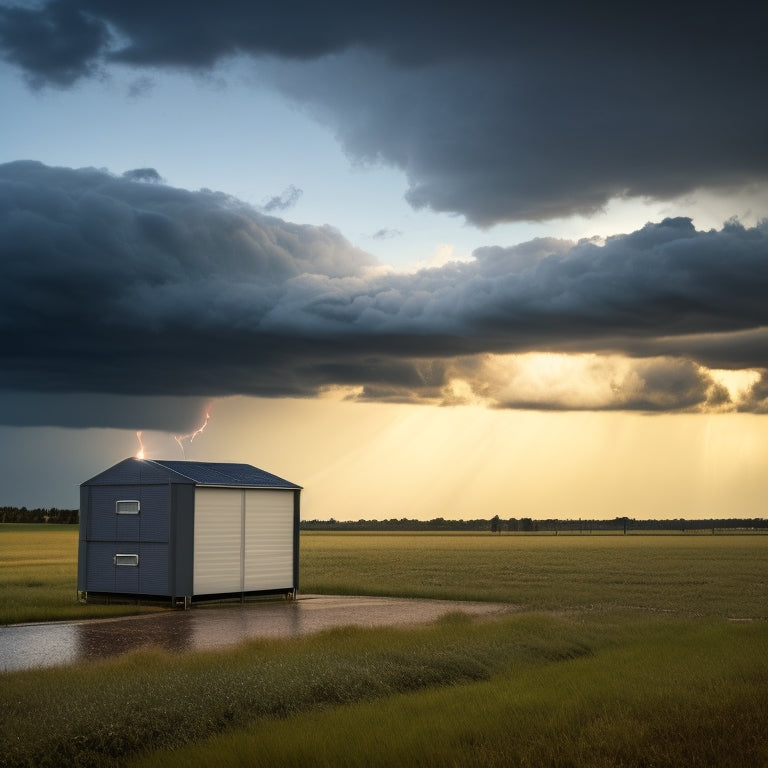
Protect Your Panels: Hail-Proof Your Green Investment
Share
To safeguard your solar panels from hail damage, you'll need to take a multi-faceted approach. First, assess the hail damage risk in your area and identify vulnerabilities in your green roof design. Then, choose materials with high durability and impact resistance ratings, and install protective barriers to shield your panels. Regular maintenance checks, including cleaning and inspecting connections, are also essential. By understanding your insurance and warranty options, you can guarantee financial security against hail damage. Now that you've taken the first step towards hail-proofing your green investment, uncover the specific strategies and best practices that'll give you peace of mind and protect your panels for years to come.
Key Takeaways
- Assess hail damage risk by evaluating frequency, identifying vulnerabilities, and analyzing roof structure, drainage, and vegetation for resilience.
- Choose durable materials with high impact resistance ratings, such as waterproofing membranes, growing mediums, and resilient vegetation.
- Install protective barriers to shield solar panels, performing regular maintenance, including cleaning and inspecting connections.
- Schedule seasonal inspections to identify potential issues early, inspecting panels for damage, corrosion, or debris accumulation.
- Consider insurance and warranty options, including property damage and business interruption insurance, to ensure financial security against hail damage.
Assessing Hail Damage Risk
When investing in a green roof, it's essential to evaluate the risk of hail damage to confirm your investment doesn't wither under the impact of severe weather conditions.
You need to take into account the hail frequency in your area, as this will impact the likelihood of damage. Conduct a damage assessment to identify potential vulnerabilities in your green roof's design.
Renewable energy sources like solar and wind can also be integrated into your green roof to reduce carbon footprint.
Analyze the roof's structure, drainage system, and vegetation to determine how well they can withstand hailstorms. This assessment will help you prioritize areas that require reinforcement or modification to minimize damage.
Choosing the Right Materials
Three key components of a hail-resistant green roof are the waterproofing membrane, growing medium, and vegetation.
You'll want to choose materials that excel in material durability and impact resistance. For instance, when selecting solar panels for your commercial vehicle, consider efficiency ratings to maximize energy output, and look for durable and weather-resistant options with ratings like IP67 or MIL-STD-810G.
The growing medium should be able to absorb and distribute the force of hailstones without compacting or washing away.
Vegetation selection is also critical, as some plants are more resilient to hail damage than others. Consider plants with flexible stems and leaves that can absorb impact without breaking.
Installing Protective Measures
You've selected the right materials for your hail-resistant green roof; now it's time to focus on installing protective measures that will guarantee your investment remains intact.
Regular maintenance, including cleaning and inspecting connections, is essential for optimizing performance and safeguarding longevity, as regular cleaning of solar panels can prevent up to 20% efficiency loss.
Installing protective barriers is vital to shield your panels from hail damage. You'll need to employ advanced installation techniques to confirm these barriers are securely fastened to your roof.
This may involve using reinforced brackets, adhesive bonding, or specialized fastening systems. Properly installed protective barriers will distribute the force of hail impacts, preventing damage to your panels.
Regular Maintenance Checks
Kick-start your maintenance routine by scheduling regular checks to confirm your hail-resistant green roof remains in top condition.
You'll want to perform seasonal inspections to identify potential issues before they escalate. Additionally, consider the impact of electrical infrastructure upgrades on your overall budget, as upgrading to three-phase systems may be necessary for higher power demands electrical capacity assessments.
During these checks, inspect your panels for signs of damage, corrosion, or debris accumulation. Implement effective cleaning techniques, such as soft-brush cleaning or low-pressure washing, to remove dirt and debris that can compromise your system's performance.
Additionally, verify that all connections and seals are secure to prevent water ingress. By staying on top of maintenance, you'll confirm your green roof continues to generate clean energy while maintaining its hail-resistant integrity.
Insurance and Warranty Options
Most green roof owners invest a substantial amount in their hail-resistant systems, making it essential to protect that investment with thorough insurance and warranty coverage.
You'll want to investigate various coverage types, including property damage and business interruption insurance. Additionally, consider the benefits of solar energy adoption, such as reduced carbon footprint, which can lead to significant cost savings and environmental benefits.
Review the warranty options provided by your system manufacturer or installer. Understand the claim processes and verify they're straightforward and hassle-free.
Having a detailed insurance and warranty plan in place will give you peace of mind and financial security in the event of hail damage. By doing so, you'll be able to enjoy the benefits of your green roof investment without undue worry.
Frequently Asked Questions
Can I Install Hail Protection Myself to Save Money?
You're considering DIY installation to save a buck, but be cautious - while it may seem cost-effective, improper hail protection can lead to costly repairs down the line, negating any initial savings.
How Long Does a Hail-Resistant Solar Panel Last?
You'll find that hail-resistant solar panels with advanced features like reinforced glass and sturdy frames can last up to 30 years or more, ensuring your solar panel durability and maximizing your return on investment.
Are Hail-Proof Coatings Available for Existing Solar Panels?
In the Wild West of solar technology, you'll find hail-proof coatings for existing panels, shielding them from hail damage and preserving solar efficiency; applying these retrofits is like donning armor, ensuring your green investment remains unscathed.
Do Hail Protection Systems Void My Solar Panel Warranty?
You're wondering if hail protection systems void your solar panel warranty; typically, they don't, but it's essential to review your warranty coverage carefully, as some manufacturers may exclude hail damage or require specific installation methods to maintain validity.
Can I Claim Hail Damage on My Homeowner's Insurance?
You'll likely be able to claim hail damage on your homeowner's insurance, but you'll need to review your policy carefully, as coverage and deductibles vary; don't assume it's automatically included, and be prepared to provide evidence of damage when filing your insurance claim.
Related Posts
-

3 Best Solar-Powered Biodegradable Accessories for Your Home
You're taking a significant step towards a more sustainable lifestyle by incorporating solar-powered biodegradable ac...
-

What Are Natural Clay Paints for Green Home Interiors?
You're about to uncover a game-changing alternative to synthetic paints that not only enhances the aesthetic of your ...
-

Why Grow Up? Vertical Gardens Transform Urban Living
As you change your urban living space, you're not just growing up - you're bringing nature back into the heart of the...


